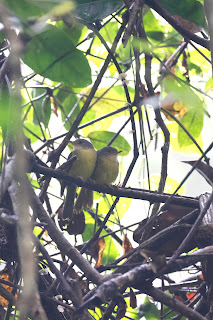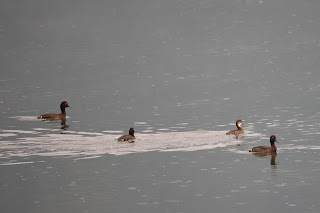Today would be our only full day in Benamevika, which meant we had a lot of birds that we wanted to try and see in a very short space of time. Our plan was to start early and try to do what we could to locate the Madagascar Serpent Eagle in the last place where the guides heard the bird. We set off at 05:30 and headed along the road, picking up our first target with Madagascar Partridge on the way.
As we passed, we overlooked an area of marsh where later in the day we planned to search for Slender-billed Flufftail. However, on passing, we heard a bird calling, and our guide decided that now would be a better time to see this most difficult of species. So down we went and set up on the edge of the marsh. The bird was not especially responsive, but it sounded like it was approaching slowly. However, the whole situation turned a little bit weird when the guide walked out into the middle of the marsh and started to walk around, almost looking for the bird. He did flush it twice allowing us to get flight views. But then he chased it down and caught the bird, which we had not anticipated at all. While it was awesome to see such an elusive bird up close, it was a bit strange, and even stranger when they charged us for this service later, without ever telling us there was a cost involved.
In addition to the flufftail, the marsh also provided us with distant views of three Malagasy Harriers, a male and two ringtails. The ringtails came much closer in the end, but the male remained always distant, which was a bit of a shame. Our other marshland target was the small Grey Emutail, a type of warbler. We put on a tape for the bird and immediately had a response from a bird nearby, which quickly came in close to inspect the visitor to its territory, followed by its partner. After getting brilliant views, we left the marsh to continue our search for the remaining targets.
From the marsh area it was just a short walk into the forest. On the way, next to the road, we had decent views of a pair of Pitta-like Ground-Rollers calling to each other in the vegetation. Our walk through the forest itself did not produce the Serpent Eagle, and there were not so many flocks to inspect, but the footpath did lead us down to another of the lakes in the area where there was another pair of Madagascar Pochard, and a nice confiding Madagascar Grebe. Exploring the forests on the other side of the road got us excellent views of Madagascar Blue Pigeon, as well as a showy pair of Dark Newtonia.
On our way back for lunch we tried to find Madagascar Snipe in a boggy area, but we failed to have even a sniff. After lunch we tried a different patch of forest completely, specifically to search for the Red Owl, as well as to try for the Serpent Eagle again. Sadly, it started to rain not long after we started, and a brilliant morning gave way to a frustrating afternoon where we were unable to find Red Owl in any of the known roosts, and the rain meant very little in the way of activity in the forest.
Concerned by the lack of Red Owls we decided to go on a night walk to try and tape an individual in there, as insurance should we not find it in the morning. We started the walk by checking again the boggy areas of Madagascar Snipe, and at dusk in the flufftail marsh, we were rewarded with an individual displaying right over our heads. Sadly our endeavor was not rewarded with any Owls, although we had a few Madagascar Nightjars and a few Chameleons, as well as a rather dopey species of Forest Rat.
-Slender-billed Flufftail
-Grey Emutail
-Pitta-like Ground Roller
-Meller's Duck
-Madagascar Pochard
-Madagascar Grebe
-Dark Newtonia
-Malagasy Harrier
-Madagascar Partridge
-Madagascar Stonechat
-Madagascar Blue Pigeon
-Madagascar Starling
-Mascarene Martin
-Common Brown Lemur
-Malagasy Forest Rat sp.
-Six-lined Water Snake
-Phelsuma punctulata
-Malthe's Green-eared Chameleon
-Guillaumet's Side-striped Chameleon
-Heterixalus sp.
-Heterixalus sp.
-Rainbow Milkweed Locust
-Crimson Dropwing
-Jersey Cudweed
Species List:
Benamevika: White-faced Whistling Duck, Meller's Duck,
Red-billed Teal, Madagascar Pochard, Madagascar Partridge, Common Quail, Madagascar
Grebe, Malagasy Turtle Dove, Madagascar Blue Pigeon, Blue Coua, Malagasy Coucal,
Madagascar Cuckoo, Madagascar Nightjar, Alpine Swift, Madagascar Flufftail, Slender-billed
Flufftail, Common Moorhen, Madagascar Snipe, Madagascar Harrier-Hawk, Malagasy
Harrier, Frances's Sparrowhawk, Madagascar Buzzard, Rainforest Scops Owl, Cuckoo-roller,
Malagasy Kingfisher, Olive Bee-eater, Broad-billed Roller, Pitta-like Ground
Roller, Malagasy Kestrel, Common Newtonia, Dark Newtonia, Red-tailed Vanga, Crested
Drongo, Malagasy Paradise Flycatcher, Madagascar Lark, Green Jery, Madagascar
Cisticola, Malagasy Brush Warbler, Madagascar Swamp Warbler, Grey Emutail, Spectacled
Tetraka, Mascarene Martin, Brown-throated Martin, Malagasy Bulbul, Malagasy
White-eye, Madagascar Starling, Madagascar Magpie-Robin, Madagascar Stonechat, Souimanga
Sunbird, Malagasy Green Sunbird, Nelicourvi Weaver, Forest Fody, Madagascar
Mannikin, Madagascar Wagtail,





















































